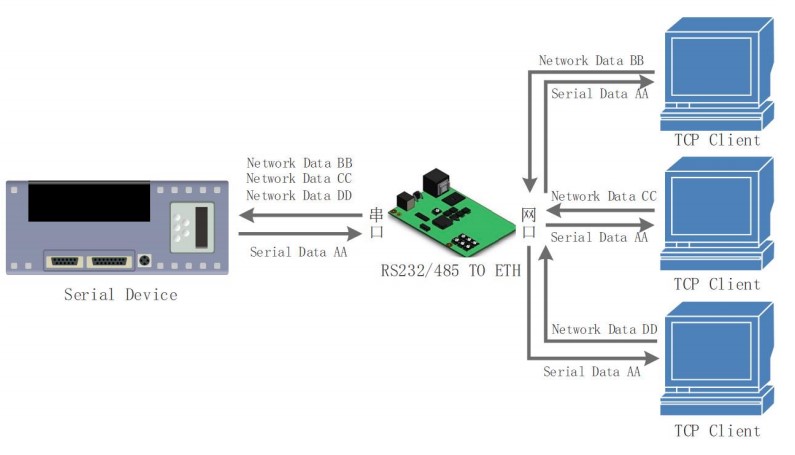The RS232/485 TO ETH is an industrial RS232/RS485 to Ethernet converter, which allows bi directional transparent data transmission between RS232/RS485 and RJ45 port Ethernet, even at the same time, it can be configured via webpage.
Key Features
- M4 series 32-bit ARM processor with up to 120MHz frequency, fast speed, stable and reliable
- 10/100M Auto-MDI/MDIX ethernet interface, regardless of cross-over or straight-through cable
- Both RS232 and RS485 interface, allows to work independently at the same time, without interfering each other
- Configurable baudrate (600bps~230.4Kbps), supports five parity check options: None, Odd, Even, Mark, Space
- Multi indicators, for monitoring communicating and working status
- Available working modes: TCP Server, TCP Client, UDP Server, UDP Client, HTTPD Client (supports GET and POST)
- Supports Modbus, suit for industrial application
- Supports Websocket, allows bi-directional transparent data transmission with RS232/RS485 port via webpage directly
- Configurable via webpage, AT commands, serial protocol, and network protocol, provides configuration protocol which can be integrated to your own software
- Supports customized heartbeat packets, make sure the connection is truthful, as well as for actively retrieving sensor data
- Supports customized registration packets, auto passing the registered packet as identifier after the connection is established, so that different devices can be distinguished
- Supports customized webpage, allows user to customize the module configuration page
- Supports RFC2217-like protocol, be able to communicate with devices whose serial setting (baudrate, data bit, etc.) may change
- KeepAlive mechanism, detects broken connection, auto re-connecting
- Supports time-out reboot (no-data reboot), ensures a long-term stable connection, configurable reboot time
- Supports DNS domain name resolution, configurable DNS server
- Supports DHCP, auto-obtained IP or static IP
- Firmware is upgradable via the network
- Restore to factory settings via software and/or hardware
- Comes with default MAC address, which is customizable
- Provided software: module configuration software, TCP/UDP testing tool, VCOM virtual serial port software
- Example code: host computer (socket ), VB, C++, Delphi, Android, iOS, etc.
Specifications
-
Ethernet:
- Connector: 4-pin RJ45
- Communication rate: 10/100Mbps
- Interface protection: 2KV electromagnetic isolation
- Protocols: IP, TCP, UDP, ARP, ICMP, DHCP, DNS, HTTPD Client, Websocket
- TX cache: 16Kbyte
- RX cache: 16Kbyte
-
RS485/RS232:
-
Connector:
- RS485: screw terminal (A+, B-, GND)
- RS232: DB9 male
-
Data bit: 5bit, 6bit, 7bit, 8bit
-
Stop bit: 1, 2
-
Parity bit: None, Odd, Even, Mark, Space
-
Baudrate: 600bps~230.4Kbps
-
TX cache: 2Kbyte
-
RX cache: 2Kbyte
-
Hardware flow control: RTS/CTS
-
Interface protection:
-
RS485: 2KV ESD protection, lightning-proof, anti-surge, over-current protection
-
RS485 pull up/down registers: 2.2KOhm
Package Content
- RS232/485 TO ETH x1
- 5V power adapter x1
- Ethernet cable x1
- Male-to-Female serial cable x1
- Female-to-Female serial cable x1
Resources
Dimensions

Application Diagram

TCP Client

TCP Server

UDP Client

UDP Server

HTTP Client

WebSocket

VCOM Application

FAQs:
Q: What is the maximum baudrate supported by the RS232/RS485 to Ethernet converter?
A: The RS232/RS485 to Ethernet converter supports a maximum baudrate of 230.4Kbps.
Q: Can the RS232 and RS485 interfaces work independently at the same time?
A: Yes, the RS232 and RS485 interfaces can work independently at the same time without interfering with each other.
Q: What protocols are supported by the Ethernet interface?
A: The Ethernet interface supports IP, TCP, UDP, ARP, ICMP, DHCP, DNS, HTTPD Client, and Websocket protocols.
Q: Can the RS232/RS485 to Ethernet converter be configured via a webpage?
A: Yes, the RS232/RS485 to Ethernet converter can be configured via a webpage.
Q: What are the available working modes for the RS232/RS485 to Ethernet converter?
A: The available working modes for the RS232/RS485 to Ethernet converter are TCP Server, TCP Client, UDP Server, UDP Client, and HTTPD Client (supports GET and POST).








